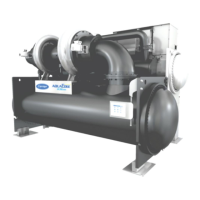97
NOTE 1: High leak rates are not acceptable. The necessary steps must be taken to eliminate any leak detected.
NOTE 2: Fixed refrigerant detectors are not designed to find leaks as they cannot locate the leak.
9.1.1 Soldering and welding
Component, piping and connection soldering and welding operations must be carried out using the correct
procedures and by qualified operators. Pressurised containers must not be subjected to shocks, nor to large
temperature variations during maintenance and repair operations.
9.1.2 Refrigerant properties
The standard refrigerant for the 19DV chiller is HFO R-1233zd(E). At normal atmospheric pressure, HFO R-
1233zd(E) will boil at 18°C and must, therefore, be kept in pressurized containers or storage tanks.
The refrigerant is practically odorless when mixed with air and is noncombustible at atmospheric pressure. Read
the Material Safety Data Sheet and the latest standard EN 378-2 to learn more about safe handling of this
refrigerant.
DANGER: HFO R-1233zd(E) in heavy concentrations may displace enough oxygen to cause asphyxiation. When
handling this refrigerant, protect the hands and eyes and avoid breathing fumes.
9.1.3 Adding Refrigerant
Follow the procedures described in Trim Refrigerant Charge section.
CAUTION : Always use the compressor pumpdown function in the PUMPDOWN/LOCKOUT feature to turn on the
cooler pump and lock out the compressor when transferring refrigerant. Liquid refrigerant may flash into a gas and
cause possible freeze-up when the chiller pressure is below -53 kPa for HFO R-1233zd(E).
9.1.4 Adjusting the Refrigerant Charge
If the addition or removal of refrigerant is required to improve chiller performance, follow the procedures given
under the Trim Refrigerant Charge section.
9.1.5 Refrigerant Leak Testing
Since parts of the refrigerant system operates in vacuum, non-condensables will enter the cooling systems. The
PIC5+ HMI will issue an alert indicating excessive purge operation. Leaks, which cause frequent purge cycles,
should be repaired without delay. Non-condensable gas in the machine causes higher than normal condenser
pressure, compressor surge at start-up and frequent purge cycles, so locate and repair any leaks as soon as
possible. Before making any necessary repairs to a leak, transfer all refrigerant from the vessel.
9.1.6 Leak Rate
Carrier recommends that leaks totaling less than the above rate but more than a rate of 0.1% of the total charge
per year should be repaired during annual maintenance or whenever the refrigerant is transferred for other service
work.
9.1.7 Test After Service, Repair, or Major Leak
If all the refrigerant has been lost or if the chiller has been opened for service, the chiller or the affected vessels
must be pressure tested and leak tested. Refer to the Leak Test Chiller section to perform a leak test.
WARNING : HFO R-1233zd(E) should not be mixed with air or oxygen and pressurized for leak testing. In general,
this refrigerant should not be present with high concentrations of air or oxygen above atmospheric pressures,
because the mixture can undergo combustion.
9.1.7.1 Testing with refrigerant tracer
Use an environmentally acceptable refrigerant as a tracer for leak test procedures. Use dry nitrogen to raise the
machine pressure to leak testing levels.
9.1.7.2 Testing without refrigerant tracer
Another method of leak testing is to pressurize with nitrogen only and to use a soap bubble solution or an
ultrasonic leak detector to determine if leaks are present.
9.1.7.3 To pressurize with dry nitrogen
NOTE: Pressurizing with dry nitrogen for leak testing should not be done if the full refrigerant charge is in the
vessel because purging the nitrogen is very difficult.

